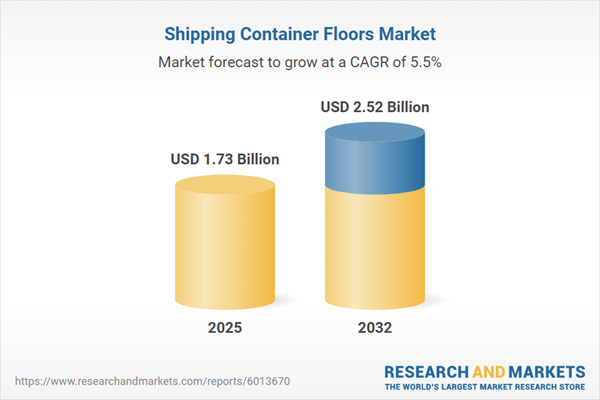Speak directly to the analyst to clarify any post sales queries you may have.
The global shipping container flooring market is transforming rapidly, driven by evolving material technologies, sustainability mandates, and the need for greater operational resilience. Senior decision-makers must understand both the dynamic trends and granular segmentation shaping this essential component in supply chain and logistics operations.
Market Snapshot: Shipping Container Flooring Market Size and Growth
The shipping container floors market grew from USD 1.64 billion in 2024 to USD 1.73 billion in 2025. It is projected to continue expanding at a CAGR of 5.50%, ultimately reaching USD 2.52 billion by 2032. This strong upward trajectory underscores the intensified global focus on optimizing flooring solutions that balance performance, sustainability, and regulatory compliance. Leaders in shipping, logistics, and manufacturing must keep pace as innovations and policy changes reshape both supply and demand on a worldwide scale.
Scope & Segmentation of the Shipping Container Flooring Market
This report offers comprehensive coverage of all major sub-segments and regional developments in the shipping container flooring industry. Key areas included are:
- Material Types:
- Aluminum
- Bamboo (including Engineered Bamboo, Moso Bamboo, Solid Bamboo)
- Composites (Fiberglass Composite, Plastic Composite)
- Hardwoods (Douglas Fir, Meranti, Okoume)
- Steel
- Container Types:
- Dry Containers
- Flat Rack Containers (Collapsible, Standard)
- Open Top Containers (Aluminum, Steel)
- Refrigerated Containers (Multi Temperature, Single Temperature)
- Tunnel Containers
- Container Sizes:
- 20 Foot
- 40 Foot
- 45 Foot
- End User Industries:
- Automotive
- Manufacturing (Electronics, Machinery, Food and Beverage)
- Pharmaceuticals
- Retail
- Transportation and Logistics
- Applications:
- Bulk Cargo
- Cold Chain
- General Cargo
- Hazardous Goods (Chemical, Flammable)
- Specialized Cargo
- Regional Coverage:
- Americas (North America, Latin America), including major economies such as United States, Canada, Mexico, Brazil, Argentina, and Chile
- Europe, Middle East & Africa, with deep dives into the United Kingdom, Germany, France, UAE, South Africa, and others
- Asia-Pacific, featuring markets such as China, India, Japan, Australia, and key Southeast Asian countries
- Featured Companies:
- UPM-Kymmene Oyj
- Stora Enso Oyj
- West Fraser Timber Co. Ltd.
- Weyerhaeuser Company
- Canfor Corporation
- Boise Cascade Company
- Arauco S.A.
- Louisiana-Pacific Corporation
- Resolute Forest Products Inc.
- Rayonier Inc.
Key Takeaways for Shipping Container Flooring Market Leaders
- Material innovation is reshaping the flooring landscape, with advanced composites, engineered bamboo, and recycled content increasingly prioritized for durability and reduced life-cycle emissions.
- Digital monitoring solutions within floor assemblies enable real-time cargo tracking and predictive maintenance, enhancing both safety and asset longevity.
- Environmental regulations are forcing a pivot away from traditional chemical treatments and high-emission processes, driving adoption of certified wood and closed-loop manufacturing systems.
- Strategic partnerships—spanning material suppliers, technology providers, and leasing companies—are critical to mitigate supply risks and address evolving customer demands.
- Regional variations inform product strategies: North America and Latin America favor hybrid and certified wood solutions, while EMEA regions focus on regulatory compliance and lifecycle performance. Asia-Pacific emphasizes technology adoption and scalable, moisture-resistant designs.
Tariff Impact and Supply Chain Resilience
The 2025 U.S. tariffs have disrupted global supply chains, prompting manufacturers to localize sourcing, adjust material mixes, and form new regional partnerships. These measures, while supporting domestic producers, introduce challenges related to cost management and procurement flexibility. Industry leaders are proactively balancing overhead with supply continuity and asset quality in response to these shifts.
Methodology & Data Sources
Insights are based on a blended methodology, combining in-depth primary interviews with container manufacturers, logistics experts, and regulators, alongside systematic secondary analysis from industry reports, patents, and trade associations. Robust triangulation and peer review processes underpin the accuracy and relevance of presented conclusions.
Why This Report Matters for Decision-Makers
- Identify actionable growth opportunities and strategic risks across regions, customer segments, and regulatory scenarios.
- Benchmark against leading suppliers and emerging technologies to inform procurement and innovation strategies.
- Support capital allocation and partnership decisions with a detailed, evidence-based view of market forces and sustainability imperatives.
Conclusion
Senior decision-makers navigating the shipping container flooring market must align operational, technological, and environmental strategies. Continued monitoring of materials, regulations, and partnerships will position organizations for resilience and long-term growth.
Additional Product Information:
- Purchase of this report includes 1 year online access with quarterly updates.
- This report can be updated on request. Please contact our Customer Experience team using the Ask a Question widget on our website.
Table of Contents
3. Executive Summary
4. Market Overview
7. Cumulative Impact of Artificial Intelligence 2025
Companies Mentioned
The companies profiled in this Shipping Container Floors market report include:- UPM-Kymmene Oyj
- Stora Enso Oyj
- West Fraser Timber Co. Ltd.
- Weyerhaeuser Company
- Canfor Corporation
- Boise Cascade Company
- Arauco S.A.
- Louisiana-Pacific Corporation
- Resolute Forest Products Inc.
- Rayonier Inc.
Table Information
| Report Attribute | Details |
|---|---|
| No. of Pages | 194 |
| Published | October 2025 |
| Forecast Period | 2025 - 2032 |
| Estimated Market Value ( USD | $ 1.73 Billion |
| Forecasted Market Value ( USD | $ 2.52 Billion |
| Compound Annual Growth Rate | 5.5% |
| Regions Covered | Global |
| No. of Companies Mentioned | 11 |









